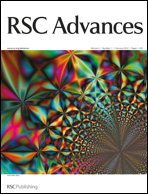Solid-state phase transformation mechanism for formation of magnetic multi-granule nanoclusters†
Abstract
Magnetic multi-granule nanoclusters (MGNCs) were easily formed by the simple reaction of FeCl3 in ethylene glycol, which served as both the solvent and reductant, in the presence of sodium acetate. Simple refluxing within glassware at atmospheric pressure allowed us to monitor changes in the color of reaction mixtures and isolate intermediates to be characterized. On the basis of these observations, we could suggest a new mechanism of solid-state phase transformation after the hydrolysis/condensation of FeCl3 along with the partial reduction of Fe3+ to Fe2+ by ethylene glycol. The size of MGNCs could be precisely and reproducibly controlled from 50 to 500 nm by varying the reaction conditions. These MGNCs exhibited relatively high MS values of 73–85 emu g−1 and ferrimagnetic properties, but they were stably dispersed in the solution via a strong interaction between solvent molecules and surface functional groups; this interaction overcame the magnetic interactions between particles that caused the formation of aggregates.


 Please wait while we load your content...
Please wait while we load your content...